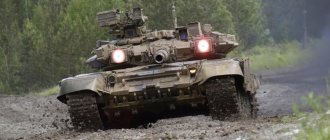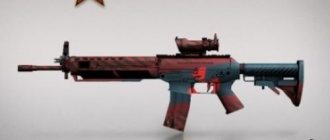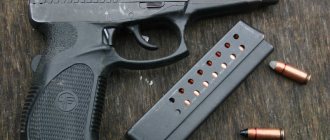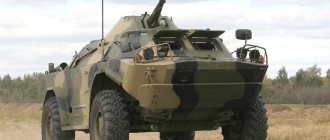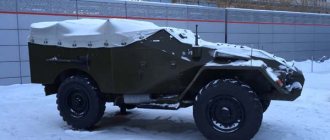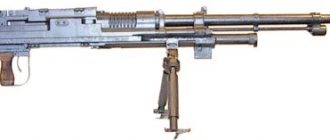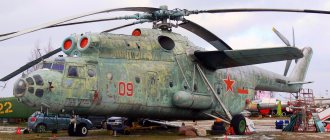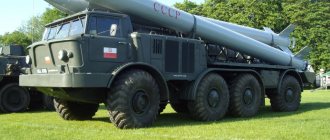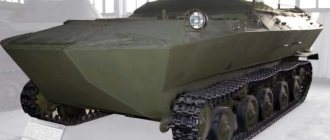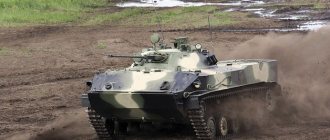After years of testing and procurement failures, the U.S. Marine Corps appears finally close to selecting and fielding its first non-tracked amphibious combat vehicle.
In December 2020, BAE Systems and its partner Iveco delivered the ACV (Amphibious Combat Vehicle) to the US Marine Corps ahead of the contract schedule. Later, in February 2020, SAIC presented its ACV platform, which it prepared in collaboration with the Singaporean company ST Kinetics.
Remarkably, both candidates for the ACV contract are wheeled platforms. Here we see a clear departure from the traditional concept of platforms for the Marine Corps, adopted in 1942 in connection with the commissioning of the LVT-1 vehicle. Tracks, considered an indispensable attribute of vehicles whose task during the first landing operations in the Pacific Ocean was to move around islands surrounded by coral reefs, became a distinctive feature of vehicles of this class.
The irony is that this simplified view could be used to define a class of vehicles based on the innovative and unconventional approach implemented by American engineer Donald Roebling in his brainchild “Alligator”, which actually served as the basis for the LVT family.
A distinctive feature of the EFV platform was that it had an exceptional speed of movement on water (up to 46 km/h)
The Alligator vehicle demonstrates its capabilities in reaching a relatively steep bank (late 30s)
Power Projection
However, this is not the first time in the ACV program that the idea that a wheeled combat vehicle can overcome the coastal strip has surfaced. Infantry are primarily a means of projecting power; their essence and meaning is to arrive in a remote combat area and then establish a friendly presence where there was previously none. How to transport weapons to a given area and then to land is the main task.
In the late 1970s, the Marines sought to improve the maneuverability of their ground component and began exploring the capabilities of light armored vehicles. The idea was to take off-the-shelf, field-proven platforms, quickly procure them, and have an easily deployable, more flexible mobile combat capability.
A thorough analysis of the available platforms on the market was carried out, with several potential candidates also demonstrating their superior amphibious capabilities. For example, at that time, Indonesia was evaluating the German TPz 1 Fuchs armored personnel carrier developed by Krauss-Maffei with two steerable propellers in the stern, since this country needed a vehicle capable of crossing the expanses of water between the numerous islands of this archipelago.
In addition, the German industry has developed the EWK APE engineering reconnaissance vehicle (photo below), optimized for carrying out engineering work in areas dominated by water bodies. Its superior maneuverability allows it to operate in strong current waters, including entering and exiting steep and challenging shorelines. But neither one nor the other car was developed to overcome surf zones and was not tested in such conditions.
However, the TPZ and APE were not officially offered to the Marine Corps when it issued its request for proposals for its Light Armored Vehicle (LAV), which included both wheeled and tracked variants. One of the contenders was the Engesa EE-11 Urutu armored vehicle with a 6x6 wheel arrangement with a unique balanced suspension, with propellers for floating and characteristics that allow it to operate in strong waves and surf. Urutu is in service with the Brazilian Marine Corps and also several other Latin American countries.
SAIC, primarily known as a service provider, has teamed up with Singapore-based ST Kinetics to offer this ACV platform
This vehicle was not selected for competitive evaluation. However, the ability to operate in open water and overcome the surf zone was not even included as “desirable capabilities,” although a number of LAV project advocates suggested it. Their idea was that an LAV with similar functionality could be launched from a landing ship or boat closer to the coastline.
Having reached the shore at the expense of its own forces (provided that the seas allow it), the LAV could, moving quickly, immediately move inland, and thereby frustrate the enemy's response. The shore is no longer a goal, but only a “milestone” that must be overcome as quickly as possible.
The concept also provided an answer to how a smaller Marine force could project power from the sea while engaging an increasingly mobile and powerful enemy. It provided the necessary mechanism for implementing maneuver warfare that allowed smaller, more maneuverable forces to successfully combat larger enemy formations through superior mobility, initiative and surprise, which was ideal for the US Marine Corps.
The LAV provided invaluable new tactical and operational capabilities for land combat, but did not solve the ship-to-shore dilemma. At the same time, the development of the LVTX (Landing Vehicle Tracked X) and later LVTA (A - Assault) projects made it possible to determine the main features of the next generation amphibious assault vehicle, which was to replace the LVTP-7 platform, adopted for service in 1972 and in the 80s, renamed AAV-7 (Assault Amphibious Vehicle - amphibious assault vehicle).
Both projects envisaged the creation of an armored vehicle with high speed on water, which, when exiting it, would become something similar to an infantry fighting vehicle. This vision resulted in the development of the EFV (Expeditionary Fighting Vehicle), which was eventually canceled in 2011 after 20 years of development. Two key issues that contributed to the EFV's demise were its survivability and size.
Survivability was not helped in any way by the flat bottom, which is necessary to maintain high speed on the water, but which does not withstand mines and IEDs (improvised explosive devices) well. Well, the dimensions were determined by the requirement to transport 17-18 infantrymen, which was a reflection of the historical desire to maximize the number of soldiers delivered ashore in each battle formation. Combat experience in Iraq, when AAV-7 armored vehicles had to move extensively overland, showed the serious consequences of placing so many infantrymen in one vehicle. It is clear that when a shell hits a car with a similar passenger capacity, the number of victims increases significantly.
Veteran project
The closure of the EFV program did not allow the Marine Corps to get rid of the armored vehicle, which had been in service for 35 years, which, despite several upgrades aimed at increasing reliability and extending its service life, had exhausted its service life, while being left without a successor in the near future. In addition, it turned out to be too vulnerable for the modern battlefield. From a budgetary perspective, it couldn't be worse, since the sequestration approved by Congress required a reduction in purchases.
This led to the MPC (Marine Personnel Carrier) project, which was intended to provide a ready-made highly mobile squad transport vehicle to complement the existing AAV-7 armored vehicles, but which was “shelved” immediately after successful demonstrations of potentially ready-made candidates. in 2013. It is worth noting that the MPC tests included not only swimming, but also entering and exiting the water on a real shoreline.
These tests of the MPC platform clearly demonstrated the capabilities of modern wheeled combat vehicles, including testing the capabilities of water operations that were not limited to simply crossing rivers, but also included overcoming open sea surfaces and coastal surf. During testing, vehicles from BAE Systems, General Dynamics, Lockheed Martin and SAIC successfully demonstrated their amphibious capabilities, compatibility with the carrier vessel, survivability and teamwork with landing forces. In the end, everything met or exceeded the Marines' expectations. At the same time, the speed on the water of the applicants was lower than the speed of the “experienced” AAV-7 (7.13 knots) and was close to 6-7 knots.
As a result, the Marine Corps revised its new multi-phased approach. First, the survivability of existing AAV-7 vehicles will be increased as a temporary measure. The competition was won by SAIC, which delivered its first prototypes in January 2020. The company's efforts were concentrated on restoring stability on water, and also, for the first time since the adoption of this vehicle, on increasing speed on water.
The second phase will look at the ACV platform, the requirements for which will be based on the results of the MPC platform demonstration. A request for proposals was issued in 2014, after which SAIC with its Terrex machine and BAE Systems with its SuperAV machine were selected. The evaluation of the 16 cars of each competing team began in March 2020 and will continue until mid-2020 when the final selection is finally made.
The initial order is 204 vehicles with an option for an additional 400 vehicles. This Phase 1.1 contract may be followed by a Phase 1.2, under which the vehicle will be further developed based on field experience and additional options may be offered.
BAE Systems' ACV offering is based on the Iveco SuperAV platform
Indian modernization of the Sarath infantry fighting vehicle, FICV failure
At the beginning of June 2020, the Indian military command announced problems with the program to create a new promising FICV infantry fighting vehicle, and the beginning of modernization of the existing Sarath infantry fighting vehicles. What is an Indian infantry fighting vehicle? What variations and upgrades of this machine exist? What does the Indian military want to improve? What was the program to create a new infantry fighting vehicle and why did it fail? Read our material.
In the summer of 1987, the Indian army began to receive new Sarath infantry fighting vehicles assembled at local factories from Soviet components. This BMP was actually a licensed copy of the BMP-2. Subsequently, India was able to fully establish the full production cycle of the Sarath, which made it possible to quickly equip its armed forces with a relatively good infantry fighting vehicle. It is noteworthy that during mass production, Indian designers have repeatedly made improvements to the design of the infantry fighting vehicle. Thus, communications, gun stabilizer, etc. were significantly improved. As of 1999, the Indian army had a significant number of these vehicles, the number of which, according to various sources, reached 1200 units.
The main armament of the Indian BMP-2 "Sarath" is a stabilized 30 mm Medak automatic cannon, as well as a launcher for 9M113 "Konkurs" anti-tank missiles mounted on the roof of the turret. The weight of the vehicle is 14.3 tons, the hull can accommodate three crew members and 7 landing personnel. Multi-fuel engine UTD-20 with a power of 300 hp. capable of accelerating the BMP-2 on the highway to a speed of 65 km/h. The armored vehicle is capable of floating on water at speeds of up to 7 km per hour, providing crossings across rivers and lakes.
BMP "Sarath" with a mine trawl
During serial production, in addition to the basic version of the infantry fighting vehicle with a turret and a 30-mm cannon, Indian designers developed several variants of other vehicles using the Sarath chassis. These included: a medical vehicle, a mortar self-propelled gun CMTV, a NAMICA ATGM complex and a number of others.
Medical vehicle based on the Sarath infantry fighting vehicle, self-propelled guns with an 81-mm CMTV mortar, NAMICA ATGM complex
In addition, Indian designers tried to create a self-propelled gun with a 105-mm gun on the basis of an infantry fighting vehicle, but this idea was not successful and ended only with the construction of prototypes.
"Sarath" with a 105 mm gun
However, already at the end of the 20th century it became clear that the BMP-2 was rapidly becoming outdated and needed either replacement or serious modernization. Therefore, already at the end of the 90s, a program was launched in India to create a new infantry fighting vehicle to replace the Sarath. In the 2000s, Indian designers introduced a new infantry fighting vehicle called “Abhay”. This infantry fighting vehicle was a kind of reworking of the BMP-2 with increased armament and power. It had one 40-mm Bofors gun with 210 rounds, a 30-mm automatic grenade launcher, a PKT machine gun and two launchers with the ability to accommodate the Milan or Konkurs ATGM. A new 550 hp engine was installed in the car. and a modern fire control system. The crew consisted of 3 people and 7 paratroopers. "Abhay" compared to the BMP-2 has seriously gained weight, which amounted to 23 tons. But according to the Indian side, the new infantry fighting vehicle has retained its amphibious properties.
BMP "Abhay"
However, due to a number of technical shortcomings, problems with financing and US sanctions imposed on India at that time, this infantry fighting vehicle remained only in the form of prototypes. Realizing that the domestic industry would not be able to quickly provide the army with modern infantry fighting vehicles, the Indian military in 2007 was forced to resort to the second option of strengthening its army, namely, modernizing the existing Saraths and continuing its production. But here, too, the Indian military was in for an unpleasant surprise in the form of insufficient funding for large-scale modification of hundreds of existing vehicles. It was planned to involve private Indian companies in the modernization project, but this did not bring results. As a result, the order for improvements to Sarath was constantly delayed and could only be implemented in 2020 after concluding a contract with state-owned companies Ordnance Factory Board and Bharat Electronics Ltd. The cost of the contract was estimated at 24 billion rupees ($370 million).
Under the terms of the contract, the Sarath infantry fighting vehicles were to receive a new fire control system, night vision devices, panoramic sights, launchers for mounting third-generation ATGMs and a new 380 hp engine. In total, it was planned to modernize about 693 Sarath infantry fighting vehicles. In addition, already in 2018, the Indian Ministry of Defense signed a contract for the purchase of 149 infantry fighting vehicles. The order value is estimated at 9.2 billion rupees ($150 million). As Indian military representatives indicated, this contract will be in addition to the modernization of existing vehicles. At the same time, the Indian military stated that this order could be increased, since due to the lack of new developments in infantry fighting vehicles, they would like to strengthen the power of the army with at least a larger number of Sarath infantry fighting vehicles. In total, the Indian army leadership would like to purchase approximately 362 additional units.
At the same time, there were new attempts to create a modern Indian version of the infantry fighting vehicle. Back in 2008, the Indian Ministry of Defense planned to develop from scratch and launch production of an Indian infantry fighting vehicle with plans for the subsequent purchase of about 2,610 units. This infantry fighting vehicle was supposed to replace the existing Sarath in service in the future. The entire development and production cycle had to be completed by 2022, after which large-scale purchases of the vehicle would begin. After working out the technical requirements of the military, in 2010 a competition was announced among Indian companies to develop the latest infantry fighting vehicle for the needs of the Indian army.
The struggle unfolded among a dozen Indian companies, although the creation of a combat vehicle was complicated by the virtually complete lack of experience in creating modern combat vehicles among existing enterprises in India. On the other hand, the military’s requirements for infantry fighting vehicles were also very serious. The new infantry fighting vehicle was to be equipped with a rapid-fire cannon and machine guns, and a modern ATGM with the ability to destroy armored vehicles at a range of up to 4 kilometers. The armored hull was supposed to protect the crew and troops from armor-piercing bullets of 14.5 mm caliber. In addition, the infantry fighting vehicle was supposed to have amphibious properties and the ability to be transported on transport aircraft such as IL-76 and S-17. The infantry fighting vehicle itself was to be assembled entirely with Indian components. According to the plans of the Indian military leadership, only two companies were to remain in the final of the competition, from which it was expected that the winner would be selected. The program itself was called FICV (Future Infantry Combat Vehicle) “Future Infantry Combat Vehicle”.
In 2012, at an arms exhibition in India, the first models of infantry fighting vehicles created for the needs of the Indian army were shown. One of the samples of the new infantry fighting vehicle was presented by the Chakra Rath company. It was a wheeled version of the infantry fighting vehicle, which, by the way, looked more like a homemade “guntruck” from the Middle East than a factory model of the equipment. The fact is that the body of the BMP-2 with a standard turret was actually mounted into the back of the truck. This combat vehicle had power steering, air conditioning, and was lighter in weight than its tracked counterpart. According to the designers, it was supposed to be used in military units located in areas with a well-developed road network, in urban agglomerations and peacekeeping missions. However, the creativity of the designers was not appreciated by the Indian military, and subsequently this BMP model was not demonstrated anywhere.
Indian version of the infantry fighting vehicle on a wheeled base
Another Indian company, Tata Motors, presented mock-ups of its version of the infantry fighting vehicle. The first version had a wheelbase, had a combat module with a 40-mm cannon and a coaxial 7.62-mm machine gun. On the right side of the turret there were two launchers for anti-tank missiles. It was assumed that the vehicle's crew would be three people, plus at least 6 paratroopers. The BMP was supposed to receive a modern digital fire control system, in particular, a panoramic commander's sight. The approximate weight was 20 tons, the vehicle had enhanced mine protection and amphibious properties. The estimated speed was 100 km per hour.
Model of a wheeled version of a promising Indian infantry fighting vehicle
The second version of the vehicle featured a tracked propulsion system, a combat module similar to the wheeled version, a hull layout and armor. Moreover, this infantry fighting vehicle was supposed to reach a maximum speed of up to 70 km per hour. By the way, already on the mock-up, some experts were able to see that the rear hatch for paratroopers to exit looked inconvenient, but everyone agreed that this version of the vehicle was not yet final.
Layout of a tracked version of a promising Indian infantry fighting vehicle
However, the FICV program would soon face serious upheaval. First of all, the Indian Ministry of Defense was unable to find a common language with the companies participating in the competition. Thus, the military leadership planned that up to 90 percent of the funds for the creation of a new infantry fighting vehicle would be allocated by private companies. At the same time, the companies themselves did not want to create promising infantry fighting vehicles at their own expense without serious guarantees from the Ministry of Defense about the acceptance of their products into service, citing the fact that such projects around the world are primarily paid for by the state. Some of the military's demands were also considered too exaggerated. As a result, the FICV program was closed until 2014.
It is worth noting that during this period of time, the Russian side offered India very ambitious projects in the form of modernizing the existing Sarath infantry fighting vehicles with increasing their power in the form of installing a new engine and installing the Berezhok combat module. In addition, the sale of technical documentation for the production of BMP-3 in India was proposed. However, the Indian side rejected all these proposals and returned to the FICV program. The Ministry of Defense had to simplify some of the requirements for the creation of a promising infantry fighting vehicle, including this time allowing foreign companies to be involved in the design of a new infantry fighting vehicle.
Tata Motors took advantage of the change in the conditions for creating a promising infantry fighting vehicle, in particular, the permission for foreign companies to participate, by concluding an agreement with the American General Dynamics Land Systems on the joint development of the vehicle. This made it possible to demonstrate a prototype of a wheeled infantry fighting vehicle at an arms exhibition in 2014. The vehicle was named TATA Kestrel and differed from the previously shown model by a different combat module, which housed two remotely controlled machine guns, two separately installed Javelin ATGMs and a 30-mm Bushmaster cannon.
According to the designers, this infantry fighting vehicle weighs from 18 to 26 tons, depending on the configuration, however, starting from 22 tons, the vehicle loses its amphibious properties. The 600-horsepower diesel engine allows the car to accelerate up to 110 km per hour on the highway, more than 6 km per hour on water. A controlled air suspension is installed on which the stiffness and travel are adjusted depending on the speed and road conditions. The vehicle has mine-resistant armor that can withstand explosions of up to 10 kg of TNT. The crew consists of two people and eight paratroopers.
TATA Kestrel at an arms exhibition in 2014
It is worth noting that the joint work with the American company was not in vain for Tata Motors and 60 percent of the infantry fighting vehicles ended up being made from foreign parts. However, the Indian company believed that later they would be able to get rid of foreign components by switching to domestic ones. The combat module was also not to the taste of the Indian military, so the following year this infantry fighting vehicle was shown without a turret.
TATA Kestrel without turret
However, already at the 2020 arms exhibition, apparently to demonstrate “import substitution,” the Kestrel was presented in a variation with a turret from the Sarath infantry fighting vehicle. According to the developers, the armor steel was produced abroad, but the main components and assemblies were of Indian origin. At the same time, on the basis of this vehicle, the developer company was ready to produce a whole series of various combat and auxiliary vehicles. It was proposed to change the combat module depending on customer requirements. It was expected that this machine would pass all tests by 2020 and after that its mass production would begin. But neither by 18 nor later was the vehicle accepted for service.
TATA Kestrel with a turret from the Sarath BMP
In 2020, Kestrel was again demonstrated at another weapons exhibition with a new combat module. However, to this day this infantry fighting vehicle remains only a prototype. Since the Indian leadership is still experiencing problems with funds for the serial launch of a new infantry fighting vehicle. It is also questioned whether the Indian army needs such an infantry fighting vehicle at all, since the main vehicles of this class in India are tracked vehicles. At the same time, wheeled versions of infantry fighting vehicles in a number of regions of India may experience problems with maneuverability and be unable to carry out their combat missions. Moreover, the Indian military leadership planned to put the latest infantry fighting vehicles on combat duty near the borders with China and Pakistan, i.e. to areas of main tension.
TATA Kestrel
After the virtual failure of the FICV program, the Indian leadership was forced to once again begin modernizing the Sarath infantry fighting vehicle. At the beginning of June 2020, it was announced that a contract for the modernization of 156 infantry fighting vehicles worth 11 billion rupees had been signed. At the same time, the Indian military leadership is counting on the modification of 1,600 Sarath infantry fighting vehicles produced earlier. According to the Indian side, the modernization will include new control systems, Kornet-E anti-tank missile systems, and new generation night vision devices. Changes to the security system are planned.
It is worth noting that at the moment in India there are several options for modernizing the Sarath infantry fighting vehicle. So, back in 2014, at the Defexpo-2014 arms exhibition, a model of a joint Indian-Israeli modification of the BMP-2 was presented. This vehicle received a narrower body and, according to the designers, the ability to install dynamic or active protection. The BMP received a remote-controlled combat module with the ability to install various guns, including the basic 30-mm 2A42 with a coaxial machine gun. At the customer's request, the vehicle can also be equipped with launchers for anti-tank missiles. This infantry fighting vehicle was supposed to have a modern fire control system.
Model of the Indian-Israeli modernization of the BMP-2 at an arms exhibition
However, even then this modernization looked more than doubtful, and apparently it was destined to remain in the form of a model. On the other hand, attempts to create a modernized version of the BMP-2 in India did not stop, and by 2020 the Indian industry was able to create a truly interesting example of the modification. Thus, the improved version of the infantry fighting vehicle includes a new combat module with an automated fire control system. The armored hull was lengthened due to the installation of an additional pair of rollers. Water cannons have been installed. Measures have been taken to improve living conditions for the crew and landing forces. The landing hatches in the stern have been replaced with one large door.
Promising Indian modernization of BMP-2
It is worth noting that several countries are currently improving the BMP-2, including Russia, installing Berezhok combat modules.
Today, due to the aggravation of the situation on the borders with China and Pakistan, the modernization of the Sarath infantry fighting vehicle will quickly increase the combat effectiveness of Indian infantry fighting vehicles in service. The actual failure of the FICV program could leave India with old-style infantry fighting vehicles for a long time. Modernization of existing vehicles will at least allow maintaining the combat effectiveness of existing infantry fighting vehicles at the proper level.
Alexander Dolbysh for ANNA-News.
On the list
Five companies submitted their candidates for evaluation under the ACV1.1 project. Although the requirements did not specify the type of chassis, all proposed platforms were wheeled. Most of the proposed platforms were also evaluated during the MPC platform demonstration. As a result, the Marines received a wealth of practical experience and a large amount of data on the basis of which they could draw some conclusions. In the end, at the decisive stage, each of the companies, BAE Systems and SAIC, received a contract for the supply of 16 ACV vehicles.
Both selected applicants were represented by non-American companies with extensive experience in the design, development, construction and deployment of wheeled combat vehicles. BAE Systems has teamed up with Italy's Iveco Defense to promote its SuperAV 8x8 platform. It belongs to a family of vehicles that includes the field-tested Centauro wheeled anti-tank gun and the Freccia wheeled infantry fighting vehicle.
SuperAV has been in development by Iveco since 2008 and was proposed and selected in 2010 by the Italian Armed Forces to replace their aging LVTP-7s. Designed from the outset for amphibious operations, the vehicle has hydropneumatic suspension and a unique H-drive system, where power is transferred to individual wheels via shafts running along each side of the vehicle.
This arrangement allows for a V-shaped hull, which increases the level of explosion protection, a spacious troop compartment, and maintains mobility even if several wheels are lost. Low-mounted drives also make it possible to organize compartments for increased buoyancy (and the installation of “spaced armor”) and increase stowage volume inside the vehicle.
The engine of the car is SuperAV with a power of 690 hp. provides a speed of 6 knots on water and 105 km/h on land. The machine weighs 29,000 kg and has a payload capacity of 2,700 kg. BAE ACV project manager John Swift said: “SuperAV not only meets the current 1.1 requirements, but also many of the requirements announced and/or proposed for the 1.2 option.” These include the ability to install medium-caliber weapons - most likely a 30-mm Orbital ATK Bushmaster cannon in a remotely controlled weapon module (RUVM) - launching and returning from a landing craft and transporting 13 infantrymen.
He explained that Iveco doubled the loads in all test modes in order to be sure that the SuperAV vehicle will be fully compatible with the requirements of the Marine Corps.
The Terrex 2 armored vehicle was developed by the Singaporean company ST Kinetics and is offered by the American company SAIC. It is a further development of the Terrex 1 vehicle, which was adopted by the Singapore Army, and became the basis for the Turkish Yavuz wheeled armored vehicle, created in collaboration with Otokar.
Although the previous version of Terrex 1 is a floating vehicle, the Terrex 2 platform is structurally designed for amphibious operations. The vehicle's hull is optimized for operations on water, including movement, speed and buoyancy. SAIC ACV project lead engineer Bernie Ellis said the vehicle is powered by a 600 hp Caterpillar C9.3 engine. and an Allison 4500 transmission, height-adjustable hydropneumatic suspension, all-wheel steering and twin propellers in runners. All this together allows for good maneuverability on land and water. The speed of the machine on the water is 6-6.5 knots, it is capable of operating in sea waves of up to 1 meter. SAIC said the Marines were impressed with the Terrex 2's quiet operation and the way it negotiated rough terrain.
BMP-2M scale 1/8
Hi all! I would like to put on display another one of our models in 1/8 scale. The BMP was not particularly covered on the forums, not even a detailed photo report was made. There are many innovations on this model that were not previously used on our previous models. And as they say, there is a “secret” stamp in terms of electronics, namely the stabilization of weapons. The model is made entirely of plywood by hand, without the use of laser cutting. The body parts were cut out with a jigsaw, and the rollers with a hole saw on a drilling machine. The thickness of the plywood of the body is from 4 to 8 mm. Since the model is floating on the outside, the model is completely impregnated with epoxy resin, and on the inside with moisture-resistant varnish. All suspension elements are located outside the case for complete sealing of the model. Unfortunately, this slightly affected the suspension travel, and many are accustomed to seeing how a real infantry fighting vehicle “nods” when braking, but there is no such effect here. And so the suspension is fully working. In the photo the rollers are without bandages; a rubber hose of suitable diameter was used as bandages. Gooseneck made of loops, without overlays. The pads came on the last two models. The hinges have grooves on the side to engage the drive wheel. The leader's crown is made of a 2 mm thick washer of large diameter. This is what the model looks like before painting. The BMP is equipped with two-speed gearboxes from screwdrivers plus a 2:1 reduction bevel gear, which was made to order for us. 18 volt motors with a power of approximately 100 watts each.
Since the model is floating, a wave-reflecting shield was made. It is driven by a servo drive through an overdrive belt drive from office equipment. The model was tested in the bathroom, but we went out into deep water only once and without a video camera. It floats very well in a straight line, but does not want to turn. This may be due to the lack of protective track screens, which create a tunnel effect. And so it stays well on the water, level and at the right height above the water.
The tower is made entirely of plywood plus putty. Mounted on a million-series bearing with a large diameter and minimal height. Previously there was a gearbox that worked through a regulator, but at the moment a servo drive has been installed that has been converted to constant rotation. Photo from a different model, but the principle is the same.
First tests. Putty, painting and what we get at the end. The weight of the model in running order is 15 kilograms, the battery is 12+6 volts. Tests on the street The speed of the model in high gear is 10-11 km/h, we checked it with a GPS navigator. At this speed you can have fun on a slippery surface. Well, the most important thing in this model is the stabilization of weapons. Since I am not friendly with electronics, this is the most difficult thing. But this is not an ideal job yet, I already know how to do everything correctly and all the components are in stock. Unfortunately, I’m keeping the insides a secret from the tankers for now, and there’s nothing to show. More advanced users can easily guess how everything works and is arranged. Discussion is encouraged. Enjoy watching everyone. If users are interested in our other models (T-64BM2, ATS-59, ZSU-57-2, BMD-4), then write, we will create a topic with a description. PS Added video at the request of Sergei Alexandrov Thank you.
Second generation
As noted above, the Marine Corps requirements for the ACV1.2 platform could include additional capabilities, performance enhancements, and various options. Although the current requirements define the Kongsberg 12.7 mm DUMV, the Marines at one time intended to deploy an EFV platform with a 30 mm MK44 Bushmaster II automatic cannon.
It is reasonable to assume that such an “increase in firepower” could top the list of desirable solutions. This circumstance is strengthened by the fact that the companies that presented their ACV projects had already installed these weapons on similar vehicles, and Iveco noted that they had considered a similar solution in their project. The US Army's adoption of a DUMV (also produced by Kongsberg) with a 30 mm cannon for its Stryker vehicles further simplifies this task due to the widespread availability of ammunition and technical support services for the gun, as well as the simplified adoption of an already qualified weapons module in the US.
In addition to more powerful weapons, the Marine Corps spoke in favor of integrating an active protection system (APS). For this purpose, he could take advantage of the results of work on KAZ carried out by the American army, which intends to evaluate finished systems as early as 2020. It is also developing a more advanced modular active protection system, MAPS (Modular Active Protection System).
The Corps' two-phase approach to the ACV platform will allow it to be deployed more quickly by leveraging the most available and most proven technologies, while also planning for the integration of new capabilities as they become available. The US Army is closely monitoring the implementation of the ACV project and is eager to gain experience that it can use in its accelerated deployment of the advanced Mobile Protected Firepower light tank.
The Marines would also like to add a repair/recovery and command variant to the current squad transporter. However, as Ellis noted, the Terrex 1 armored vehicle has already been configured in several versions: engineering, medical, mortar complex and anti-tank installation.
A variant that has not yet been mentioned, but has been deployed in every family of armored landing vehicles since World War II (prior to the AAV-7), is the "A" variant armed with a large caliber cannon, providing fire support for any type of amphibious operation. This is somewhat surprising given the serious concerns expressed about the current lack of artillery fire support for airborne units and the recognition of the critical importance of immediate close fire support to achieve overwhelming combat superiority.
The availability of effective weapon systems, such as the 120mm Patria NEMO mortar system, well suited for installation on light vehicles like the ACV, makes the new "A" variant a particularly attractive option.
The introduction of these and other capabilities could significantly improve the standard combined arms capabilities of ACV-equipped units and their ability to operate as an independent highly maneuverable force.
BMP-4 - yes, BMP-3 - no. While the bosses argue, the army is on starvation rations
Roads? Depends on what. At 0.85-0.9M it’s not bad; in simple beam control it can cost around a thousand euros in cost. With an automatic production line it is even lower. It is no more complicated than some cheap household appliances. My son’s toys will now be more intelligent than these, for example, they can fly around obstacles in simple obvious cases. You can do the same thing on a rocket, for example, flying along a complex trajectory. If you use completely different approaches to design and technology than are currently used. This is how it works with UAVs now. Vega lost 6 billion (actually less, the rest was cut right on the spot), so who did they give the money to again? That's it! The first prototypes of modern rockets are 60-70 years old, these are the work of the RNII before its closure, tele-guided rockets in the USSR in 1940, the “Rotkäppchen” of the Germans. There's nothing complicated there. BUT as soon as you raise the speed to 2 M, everything becomes much more interesting and more complex, some of the difficulties are removed when you reach X M. At the same time, such missiles can be made by the Corporation (USA, England, France) and Russia. Nobody else. Sharing such technology with the Chinese would be extremely imprudent for the United States. Even if it is an old gem, it can work for some time, at the same time, the appearance of solutions from China on the markets can seriously limit the capabilities of the United States and, as a result, collapse the dollar/lead to a new war. This is beneficial, because since the times of Ancient Egypt, and even in Mesopotamia, Canaan, this has been tied to the rulers (Lot would have so easily lived in a vicious city). Missile weapons are very different. From simple second-generation Malyutka-M missiles to missiles with hypersonic flight speeds.
Also for launch systems. You can stuff vertical ones and one or a couple of holes on top, from where they come out and, turning around or not, go to the goal. The time for everything about everything is tens of microseconds. It is possible to manufacture a missile in a version indifferent to bullets/small fragments. The height of the tracked transporter-ATGM of such missiles at high speed along a crossed road can be within 70mm in terms of main dimensions. In relation to tanks, this is hull height + ХХХmm.
Solving the issue of safety of use is also within the engineering capabilities of the developers. Without belittling the abilities of the current ones, I can note the blurred nature of the eyes and the traditional, high cost of solutions. The military-industrial complex in the USSR never really counted money. The time between making a decision and defeat is especially depressing. It is idiocy to demand that a rocket be as reliable as a gun. The criterion is the target hit in X seconds, not time, etc. We want to have a highly effective solution against well-protected targets, we have an X M missile, the Americans partly failed with KEM due to the low flight speed, and they had tests over the entire speed range up to several tens km/s But I think the main task is still supporting the infantry. For this, the range to the target can be a kilometer or two. It seems preferable to have automatic mortars or large-caliber grenade launchers such as the Kozlik or Metal Storm 40mm for close distances, and missile weapons for ranges of hundreds of meters. The storm has a number of limitations, therefore several goats in the 40-50mm version, in different places without a tower, will be more adequate - they don’t eat up much space, and with modern grenades like those available for 40mm and long M307, the fire efficiency can exceed that of a mortar against infantry.
You can also use physical methods of influence. Here, in general, a tank is not always needed - it’s easier to place it on other media and distances - the impact time is almost instantaneous.
Where the barrel is interesting is in 40-75mm automatic cannons with remote/temporary high-precision detonation and the above-mentioned artillery systems. In China there is PLL05, we have the original - NONA-SVK. One of the most interesting weapon systems is the CV90 AMOS and I can’t remember the so-called mortar module with a large extension barrel, like on Vienna, almost without a turret. 20 rounds per minute with high accuracy - even with ordinary mines, cassettes or fragmentation rounds with an increased destruction radius - a very serious weapon.
Tactical Revolution
Amphibious assault operations have been largely infantry-centered since their inception. It was a carefully choreographed, deliberate and methodically executed sequence of certain stages, which began with the approach of the landing forces, their sea transports and support vessels from the sea.
Although the advent of the helicopter introduced the possibility of vertical airdrops, which essentially allowed infantry units to "jump" over the coastline, landing on the coast was a process much like that of World War II. Under this scheme, landing craft position themselves offshore while infantry assault forces ride through the surf either in amphibious armored personnel carriers or open landing craft. Upon reaching the shore, the infantry deploys and secures the surrounding area for subsequent units, including artillery, tanks, and support forces, to move ashore. Once the coastline is under control, troops move inland, often with one goal - to link up with forces dropped in by helicopter.
The AAV-7, although designed to operate on land 70% of the time, retained the mission of its predecessors, which was to move as many infantry as possible to the beach. It was a personnel carrier and, despite carrying a heavy machine gun and/or automatic grenade launcher—weapons more lethal than the landing squad's standard weapons—it was rarely fully integrated into the unit's tactical formations.
In addition, as became apparent in Iraq, placing so many personnel in one vehicle can lead to significant losses. However, the ACV can break this trend by moving aggressively and quickly to the coast, which reduces the opponent's ability to react.
Existing AAVs are being upgraded by the USMC as a temporary measure
Future Opportunities
Many countries around the world are taking a very responsible approach to increasing their ability to project military power from the sea. Australia, Brazil, Chile, Indonesia, Japan, South Korea and other countries are conducting major programs to create, improve or expand amphibious forces. Given the operational flexibility and adaptability of wheeled armored platforms, the potential market for systems like ACVs is significantly expanding.
In addition, this concept radically changes the idea of an amphibious assault vehicle as a simple troop transporter. A vehicle formed around a squad forms a full-fledged tactical unit. The MPC demonstration program's approach to acquiring off-the-shelf systems and sharing information with industry early on allows the platform to be operational in less than three years.
In an era of increasing threats and force demands while simultaneously shrinking defense budgets, the Marine Corps ACV platform is an innovative system worth considering. There is a growing understanding that this machine may have very promising prospects.
/Alex Alexeev, topwar.ru/
